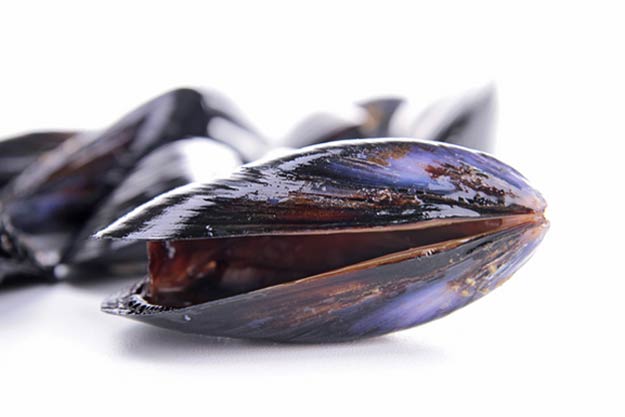Mussel Strength: How Mussels Cling to Surfaces

When mussels dangle from marine surfaces, they hold on by a cluster of fine threads. These filaments may appear flimsy, but they can actually withstand powerful impacts from currents or crashing waves. Now, researchers are unraveling the secret of these thin, bungeelike cords in order to develop more effective glues and other synthetic biomedical materials.
Unlike barnacles, which fasten themselves tightly to rocks or piers, mussels use silky fibers, called byssus threads, to loosely attach to a surface while still being able to drift and absorb nutrients in the water. So, how do these seemingly delicate threads help mussels stay put?
From laboratory tests and computer models, scientists at the Massachusetts Institute of Technology (MIT) discovered that roughly 80 percent of the length of byssus threads — the same parts of the threads that connect the mussel to a hard surface on one end — is composed of stiff material, whereas the remaining 20 percent, at the end that is affixed to the mussel itself, is soft and stretchy. The combination of these different material properties likely helps the mussels adhere to surfaces, and enables them to survive the impact of various forces. [Photos: 101 Animal Shots You'll Go Wild Over]
"It turns out that the … 20 percent of softer, more extensible material is critical for mussel adhesion,” Zhao Qin, a research scientist at MIT, said in a statement.
Researchers have studied byssus threads before, but Qin and his colleagues wanted to observe how these threads, and all their connecting parts, operate in simulated wave conditions.
"We figured there must be something else going on," Markus Buehler, head of MIT's department of civil and environmental engineering, said in a statement. "The adhesive is strong, but it's not sufficient."
The researchers placed an underwater cage in Boston Harbor for three weeks to see how mussels attached themselves to glass, ceramic, wood and clay surfaces. In the lab, the scientists used a tensile machine to test the strength of byssus threads as they were pulled and deformed.
Sign up for the Live Science daily newsletter now
Get the world’s most fascinating discoveries delivered straight to your inbox.
Even though byssus threads have both stiff and stretchy properties, the filaments are made of a protein closely related to collagen, the researchers said. From their experiments, the scientists discovered that the distribution of stiffness along the threads is critical to their effectiveness.
Understanding how byssus threads work could help scientists design synthetic materials with similarly flexible properties, such as surgical stitches that connect tissues together. The findings could also help in the development of new building materials, sensors for underwater vehicles and other equipment that could be subjected to extreme conditions, the researchers said.
The detailed findings of the study were published online today (July 23) in the journal Nature Communications.
Follow Denise Chow on Twitter @denisechow. Follow LiveScience @livescience, Facebook & Google+. Original article on LiveScience.com.

Denise Chow was the assistant managing editor at Live Science before moving to NBC News as a science reporter, where she focuses on general science and climate change. Before joining the Live Science team in 2013, she spent two years as a staff writer for Space.com, writing about rocket launches and covering NASA's final three space shuttle missions. A Canadian transplant, Denise has a bachelor's degree from the University of Toronto, and a master's degree in journalism from New York University.










